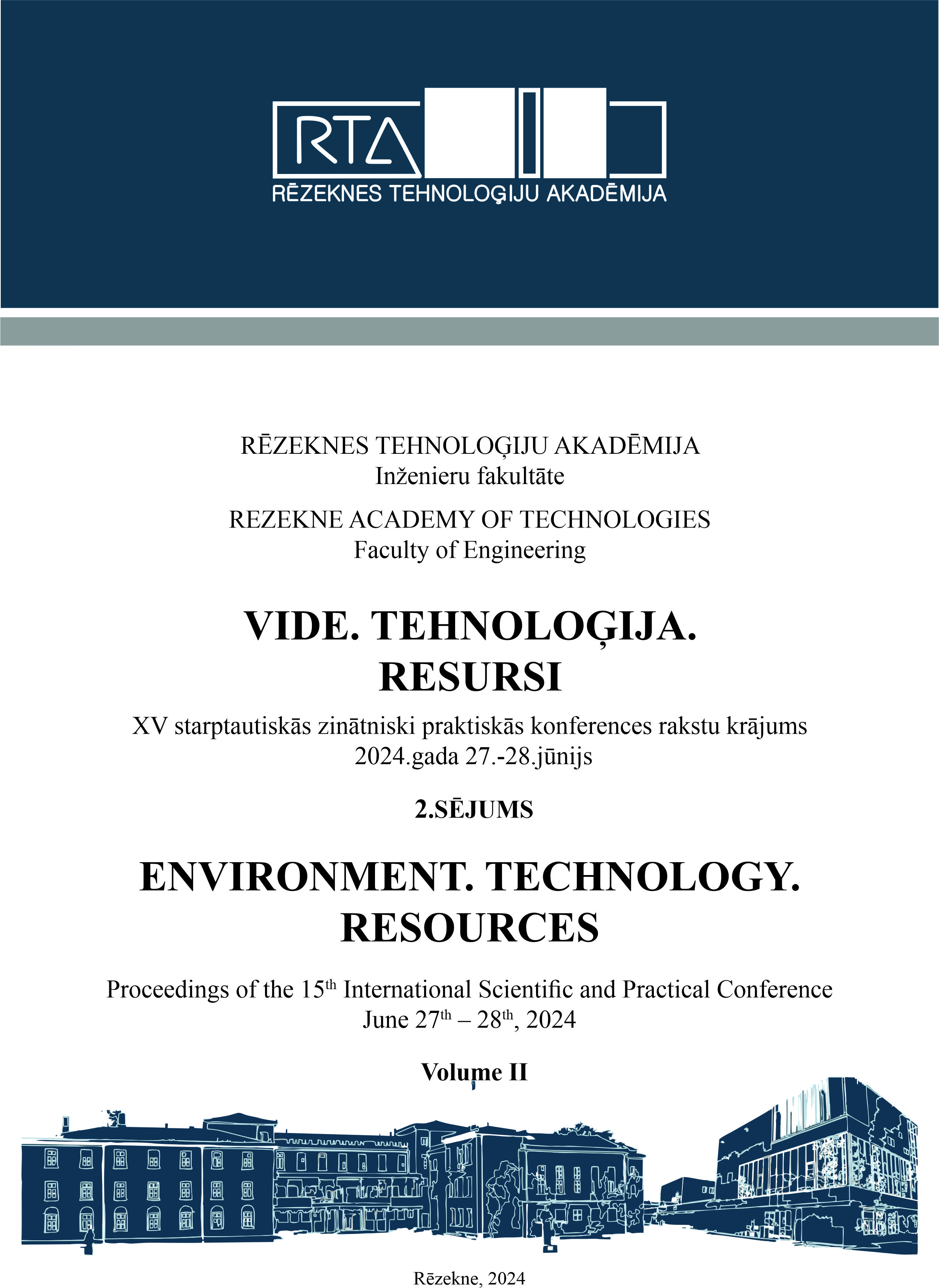REVIEW OF METHODS FOR CLASSIFYING AND ASSESSING INFORMATION UNCERTAINTY
DOI:
https://doi.org/10.17770/etr2024vol2.8024Keywords:
uncertainty and information, statistical uncertainty, numerical uncertainty, estimation of uncertaintyAbstract
There is a large number and variety of uncertainties that relate to almost all areas of life and the activity of people. Based on numerous literature sources, this article classifies various uncertainties into the following large groups: (1) stochastic uncertainties and (2) numerical uncertainties, including fuzzy and possibilistic ones. The article presents general approaches to assessing uncertainties in each of these groups. In addition, the article presents the main characteristics of general uncertainty estimates and provides an illustrative example.
References
G.J. Klir, Uncertainty and Information. Foundation of Generalized Information Theory. A John Willey & Sons, Inc., 2006
G. E. Shannon, “A Mathematical Theory of Communication,” Bell System Technical Journal, 27 (3), 1948, pp. 349 – 423.
J. Aszėl, B. Forte, and C. N. Ng, “Why the Shannon and Hartley Entropies are “Natural,” Adv. Appl. Prob., 6, 1974,pp. 131 – 146.
L. A. Zadeh, “Fuzzy sets,” Information and Control,8,pp. 338 – 353, 1965, https://doi.org/10.1016/S0019-9958(65)90241-X
M. Sugeno, “Fuzzy Measures and Fuzzy Integrals – A Survey,” Readings in Fuzzy for Intelligent Systems, pp. 251 – 257, 1993, https://doi.org/10.1016/B978-1-4832-1450-4.50027-4
D. Luca and S. Termini, “A definition of non probabilistic entropy in the setting of fuzzy set theory,” Information and Control, 20, pp. 301 – 312, 1972.
H.-J. Zimmermann, Fuzzy Set Theory – and its Applications. (Fourth Edition). New York, Springer Science + Business Media, 2001.
R.R. Yager, “On the Measure of Fuzziness and Negation, Part 1: Membership in the Unit Interval,” Int. Journal of General Systems, 5, pp. 221 – 229, 1979. https://doi.org/10.1080/03081077908547452
S. Al-Sharhan, F. Karray, W. Gueail, and O. Basir, Fuzzy entropy: a Brief Survey. 10th IEEE Int. Conference on Fuzzy Systems, December 2 – 5, 2001, Melbourne, Australia, 2001. https://doi.org/10.1109/FUZZ.2001.1008855
A Kaufman, Introduction to the Theory of Fuzzy Subsets: Fundamental Theoretical Elements. New York, Academic Press, 1975.
M–S. Kuo and G–S. Liang, “A soft computing method of performance evaluation with MCDM based on interval- valued fuzzy number,” Applied Soft Computing, 12, pp. 476 – 485, 2012. https://doi.org/10.1016/j.asoc.2011.08.020
J. M. Mendel and R.I.B. John, “Type-2 Fuzzy Sets Made Simple,” IEEE Transactions on Fuzzy Systems, 10 (2), pp. 117 – 127, 2005. https://doi.org/10.1109/91.995115
H. Bustince, J. Fernandez, H. Hagras, F. Herrera, M. Pagola, and E. Barrenchea, “Interval Type-2 Fuzzy Sets are Generalizations of Interval—Valued Fuzzy Sets: Toward a Wider View on their Relationship,” IEEE Transactions on Fuzzy Systems, 23, pp. 1878 – 1882, 2015
P. H. Burillo, H. Bustince, and V. Modehano, “Some definition of intuitionistic fuzzy number,” Fuzzy Based Expert Systems, Fuzzy Bulgarian Enthusiasts, 1994.
L. A. Zadeh, “Probability measure of fuzzy events,” J. Math.Anal. Appl., 23, pp. 421 – 427, 1965.
L. A. Zadeh, “Fuzzy Sets as a Basis for a Theory of Possibility,” Fuzzy Sets and Systems 1, pp. 3 – 28, 1978. https://doi.org/10.1016/0165-0114(78)90029-5.
D. Dubois and H. Prade, Possibility Theory – An Approach to Computerized Processing of Information. New-York: Plenum, 1988.Technology Organization,Edinburg,Australia,2007.
R.V. L. Hartley. “Transmission of Information,” Bell Technical Journal, VII (3), pp. 553 – 563, 1928. https://doi.org/10.1002/j.1538-7305.1928.tb01236.x
L. Warren, On Modeling Hybrid Uncertainty in Information.Command and Control Division,DSTO Defense Science and Technology Organization, Edinburg, Australia, 2007.
G.Wang, J. Zhang, Y. Song, and Q. Li, “An Entropy-Based Knowledge Measure for Atanasov’s Intuitionistic Fuzzy Sets and Its Application to Multiple Attribute Decision Making,” Entropy, 2018. https://doi.org/10.3390/e20120981
N. Zhao and Z. Xu, “Entropy Measures for Interval-valued Intuitionistic Fuzzy Information from a Comparative Perspective and Their Application to Decision Making,” Informatika, 27 (1), pp. 203 – 228, 2016. https://doi.org/10.15388/INFORMATICA.2016.82
S. Lee, K. L. Man, E.G. Lim, and M. Leach, “Data Analysis with Fuzzy Measure on Intuitionistic Fuzzy Sets,” Int. 2016, MultiConference of Engineers and Computer Scientists, IMECS- March 16 – 18, 2016.
J. Dombi, A. V. Laskovič, and J. Lerga, “A New Insight into Entropy Based on the Fuzzy Operators, Applied to Useful Information Extraction from Noisy Time-Frequency Distributions,” Mathematics, 2023. https://doi.org/10.3390/math11030505
M. Rahimi, P. Kumar, B. Moomlvand, and G. Yari, “An intuitionistic fuzzy entropy approach for supplier selection,” Complex & Intelligent Systems, 7, pp. 1869 – 1876, 2021. https://doi.org/10.1007/s40747-020-00224-6
A. Usha Rubi, J. George Chellin Chandran, T. J. Jain, B. N. Chaiithania, and R. Patil. “REEE – Random Forest Fuzzy Entropy for the classification of Diabetes Mallitus,” AMS Public Health, 23, 10(2). https://doi.org/10.3934/publichealth.2023030
B. Cardone, and F. Di Martio. “A Fuzzy Entropy-Based Thematic Classification Method Aimed at Improving the Reliability of Thematic Maps in GIS Environments”. Electronics, 11 (21), 3509, 2022. https://doi.org/10.3390/electronics11213509
P. D’Urso, L. De Giovanni, L.S. Alaimo, R. Mattera, and V. Vitala. “Fuzzy clustering with entropy regularization for interval-valued data with an application to scientific journal citations”. Annals of Operations Research, 2023. https://doi.org/10.1007/s10479-023-05180-1
Downloads
Published
Issue
Section
License
Copyright (c) 2024 Oleg Uzhga-Rebrov , Peter Grabusts

This work is licensed under a Creative Commons Attribution 4.0 International License.



